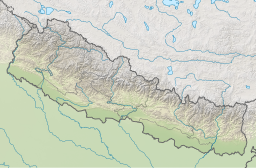Gosaikunda, also spelled Gosainkunda, is an alpine freshwater oligotrophic lake in Nepal's Langtang National Park, located at an elevation of 4,380 m (14,370 ft) in the Rasuwa District with a surface area of 13.8 ha (34 acres).[2] Together with associated lakes, the Gosaikunda Lake complex is 1,030 ha (2,500 acres) in size and was designated a Ramsar site on 29 September 2007.[3]
| Gosaikunda | |
|---|---|
| Nepali: गोसाइँकुण्ड, Nepali pronunciation: [ɡosãĩ̯kuɳɖʌ] | |
 Gosaikunda Lake in winter | |
| Location | Rasuwa district |
| Coordinates | 28°05′N 85°25′E / 28.083°N 85.417°E |
| Type | alpine, oligotrophic |
| Primary inflows | 35 L/s (1.2 cu ft/s) |
| Primary outflows | 60 L/s (2.1 cu ft/s) |
| Basin countries | Nepal |
| Surface area | 13.8 ha (34 acres) |
| Water volume | 1,472,000 m3 (52,000,000 cu ft) |
| Surface elevation | 4,380 m (14,370 ft) |
 | |
| Official name | Gosaikunda and Associated Lakes |
| Designated | 23 September 2007 |
| Reference no. | 1693[1] |
The lake melts to form the Trishuli River; it remains frozen for six months in the winter October to June. There are 108 lakes in the vicinity. The Lauribina La pass at an elevation of 4,610 m (15,120 ft) is on its outskirts.[4][5]
Religious significance
editThe Gosaikunda area has been delineated as a religious site. Hindu mythology attributes Gosaikunda as the abode of the Hindu deities Shiva and Gauri. The Hindu scriptures Bhagavata Purana, Vishnu Purana and the epics Ramayana and Mahabharata refer to Samudra manthan, which is directly related to the origin of Gosaikunda. Its waters are considered holy and of particular significance during the Gangadashahara and the Janai Purnima festivals when thousands of pilgrims from Nepal and India visit the area.[2]
According to legend, the spring that feeds the pond in the Kumbheshwar temple complex in Patan is connected to Gosaikunda. Therefore, those who cannot make the long journey to the lake, visit Kumbeshwar Pokhari instead.[6]
Gosaikunda in popular culture
editAmong the Newars Gosaikunda is known as Silu. As such it is the subject of a song and a 1987 film inspired by that song.[7][8][9]
References
edit- ^ "Gosaikunda and Associated Lakes". Ramsar Sites Information Service. Retrieved 25 April 2018.
- ^ a b Bhuju, U. R.; Shakya, P. R.; Basnet, T. B. & Shrestha, S. (2007). "Makalu Barun National Park". Nepal Biodiversity Resource Book. Protected Areas, Ramsar Sites, and World Heritage Sites. Kathmandu: International Centre for Integrated Mountain Development, Ministry of Environment, Science and Technology, in cooperation with United Nations Environment Programme, Regional Office for Asia and the Pacific. pp. 55–57. ISBN 978-92-9115-033-5.
- ^ Bhandari, B. B. (2009). "Wise use of Wetlands in Nepal". Banko Janakari (Special Issue February): 10–17.
- ^ "Gosaikunda: More than just the lake". Kathmandu Post. Retrieved 30 March 2020.
- ^ "Gosaikunda: A fair mix of adventure and spiritualism". Kathmandu Post. Retrieved 30 March 2020.
- ^ Becker-Ritterspach, R. O.A. (1995). Water Conduits in the Kathmandu Valley. New Delhi, India: Munshiram Manoharlal Publishers Pvt. Ltd. ISBN 9788121506908.
- ^ Popular lakes in Nepal, retrieved 23 April 2022
- ^ Songs of Nepal: An Anthology of Nevar Folksongs and Hymns by Siegfried Lienhard, Asian Studies at Hawaii, No. 30, Center for Asian and Pacific Studies, University of Hawaii Press, 1984, ISBN 0-8248-0680-8
- ^ "Silu - First Newari Movie". Nepali Movies. 12 November 2009. Archived from the original on 27 March 2012. Retrieved 23 April 2022.
External links
editMedia related to Gosainkunda Lake at Wikimedia Commons
